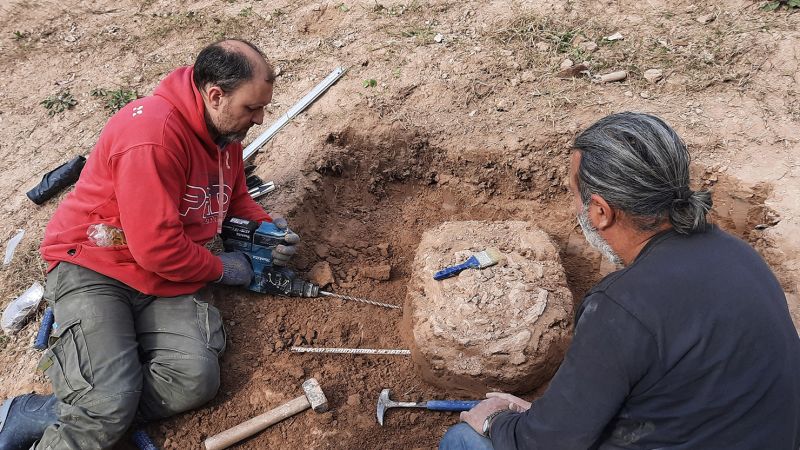Miguel Eduardo Delgado and others
Two of the researchers on the study, Martin de los Reyes (left) and Guillermo Jofre, unearth the fossil of an extinct Ice Age relative of the armadillo known as Neosclerocalyptus.
Sign up for CNN’s Wonder Theory science newsletter. Explore space with news of fascinating discoveries, scientific advancements and more.
CNN
—
More than 20,000 years ago, the earliest known people in the Americas encountered a giant armadillo-like creature in what is now Argentina and butchered it with stone tools, according to a new study.
The discovery is significant because it adds to a series of recent discoveries, based on cut marks in the fossils of Ice Age creatures, that suggest the Americas were occupied much earlier than archaeologists originally thought, possibly more than 25,000 years ago.
“These animals are closely related to modern-day armadillos,” said study co-author Miguel Delgado, a researcher at the National University of La Plata in Buenos Aires, known for their armor-like scales and ability to curl up when threatened.
“The specimen we found is one of the smallest of an extinct species of armadillo called Neosclerocalyptus,” Delgado said, noting that it weighed about 300 kilograms (660 pounds) and was 180 centimeters (nearly six feet) long, including the tail.
Bulldozers have uncovered the animal’s fossilized vertebrae and pelvis, which were found on the banks of the Reconquista River near the city of Merlo in the Buenos Aires metropolitan area.
Radiocarbon dating of bones and bivalve shells found in the same sediment layer determined that the armadillo remains were between 20,811 and 21,090 years old. Research Presentation The study was published Wednesday in the journal PLOS One.
No cuts were immediately evident, but cleaning the fossil revealed 32 linear tracks. After careful analysis, Delgado said, the team determined that the marks were not made by a rodent, a carnivore that may have been preying on the animal, or by other factors such as trampling.
Miguel Eduardo Delgado and others
In this illustration, the highlighted area (blue) shows the fossilized bones of a Neosclerocalyptus specimen unearthed during excavations near the city of Merlo, Argentina.
Instead, the team determined that the shape of the cuts was consistent with those made with a stone tool, and Delgado said the placement of the cuts suggests that the animal was butchered for its meat, with a series of deliberate cuts made around a dense area of the armadillo’s flesh.
“The cut marks were not randomly distributed but were concentrated in parts of the skeleton that housed large muscle masses, such as the pelvis and tail,” he said.
Brianna Pobiner, a paleoanthropologist and research scientist in the Human Origins Program at the Smithsonian’s National Museum of Natural History in Washington, DC, said the authors presented “compelling evidence” that the extinct armadillo was butchered by humans 21,000 years ago.
“The authors have done a solid job of demonstrating through qualitative and quantitative analysis that the cut marks on the armadillo fossils are likely human-made,” Pobiner, who was not involved in the study, said in an email.
Experts have long debated and still don’t fully understand when and how early humans first migrated to the Americas, the last place humans settled before leaving Africa and spreading across the world.
The date of the first occupation is now estimated to be between 13,000 and over 20,000 years ago, although the earliest archaeological evidence for occupation of the area is scarce and often debated.
of Discovery of fossil footprints The fossils, described in a September 2021 study, pressed into mud in New Mexico 21,000 to 23,000 years ago, are the most conclusive in a series of recent evidence suggesting that the first residents arrived much earlier than many scientists thought.
Miguel Eduardo Delgado and others
Close examination of the fossil’s cut marks revealed that they were made with stone tools in a deliberate, sequential manner.
At the time, Earth was in the midst of its Last Glacial Maximum, between 19,000 and 26,000 years ago, when two huge ice sheets covered the northern third of North America and reached as far south as present-day New York City, Cincinnati, and Des Moines, Iowa.
The cold temperatures brought about by ice sheets and glaciers would have made travel between Asia and Alaska (the most likely route) impossible at that time, meaning that the people who left the footprints probably arrived there much earlier.
parallel Giant sloth bone with three holes Archaeologists believe that armadillo bones found in Brazil were used as pendants by humans 25,000 to 27,000 years ago, and the dismembered remains suggest a surprisingly long history of human presence in South America.
Delgado said it was a “hotly debated topic” when humans first settled in the Americas, a region home to many now-extinct Ice Age creatures.
“Until recently, conventional models put humans on the continent around 16,000 years ago,” he said.
“Our findings, together with other evidence, provide a clear scenario for the timing of the first human settlement in the Americas: humans most likely first arrived in the Americas between 21,000 and 25,000 years ago, or even earlier.”


